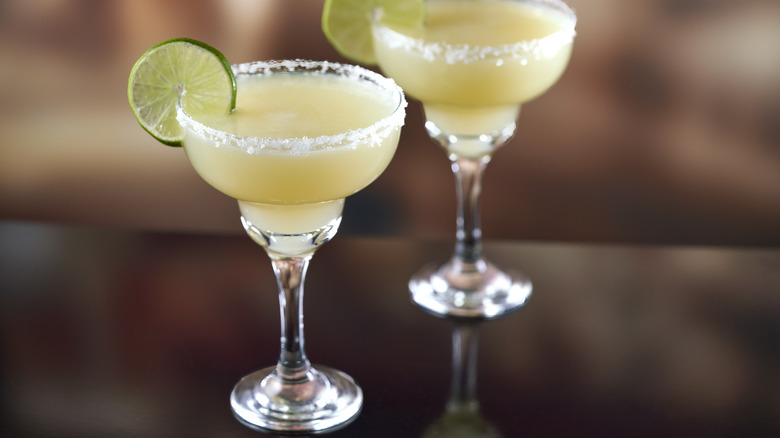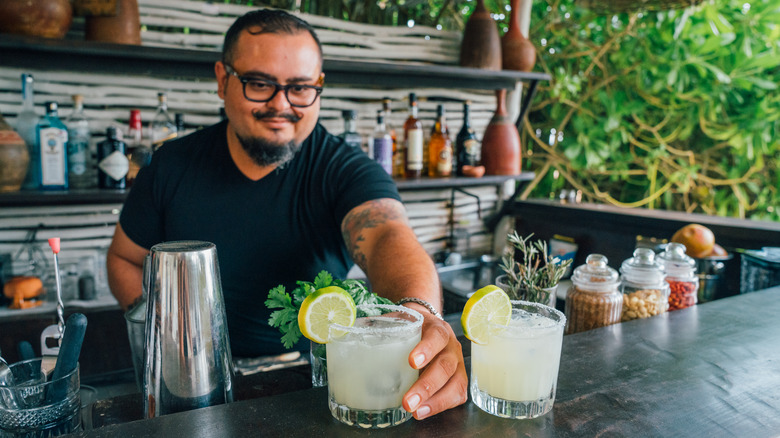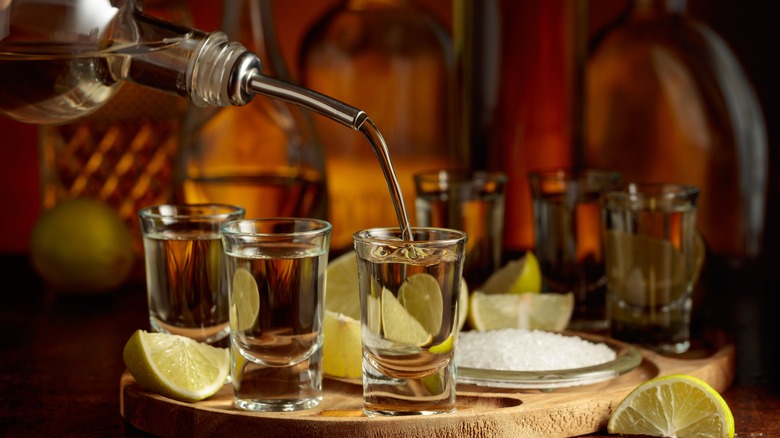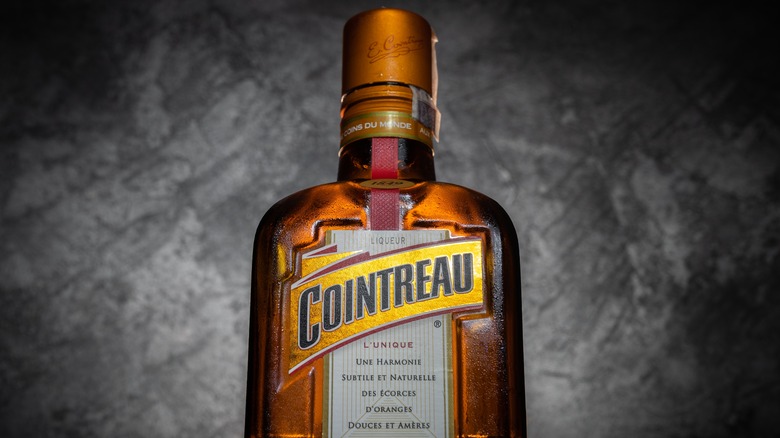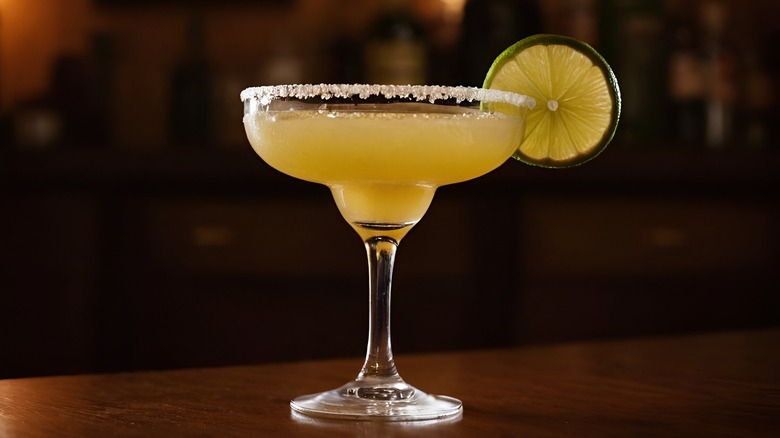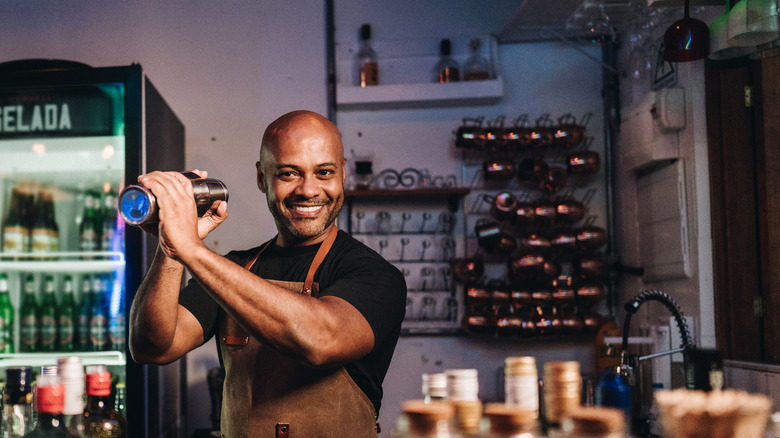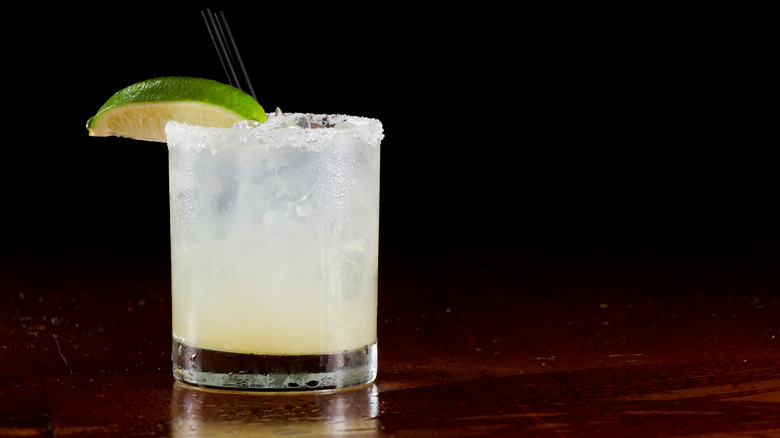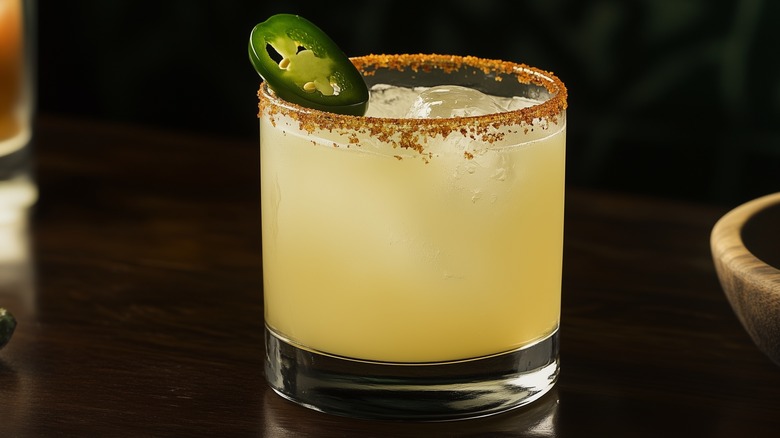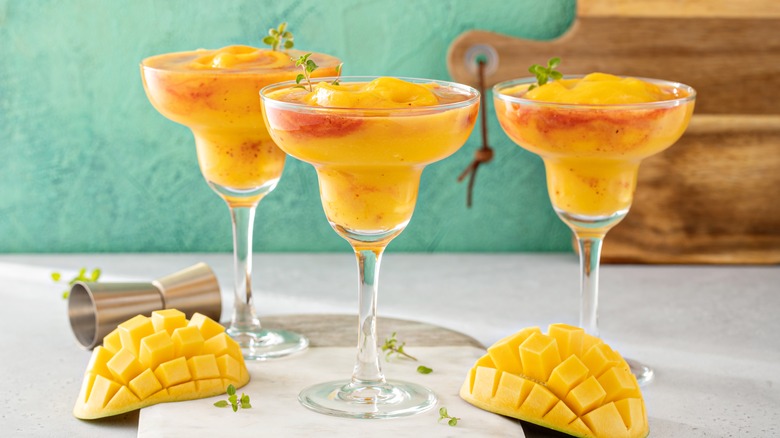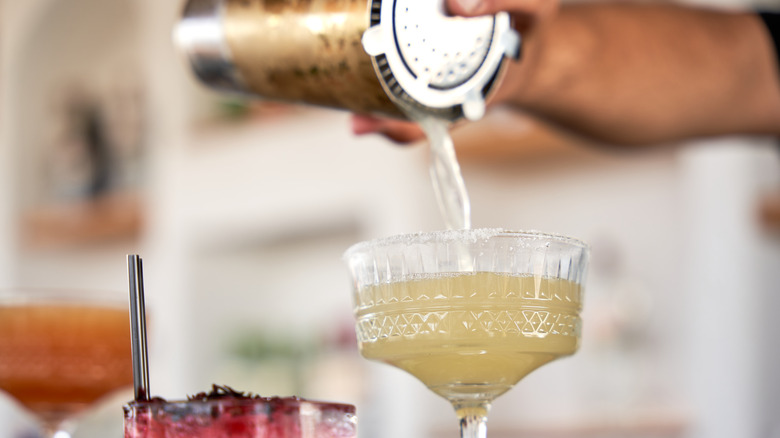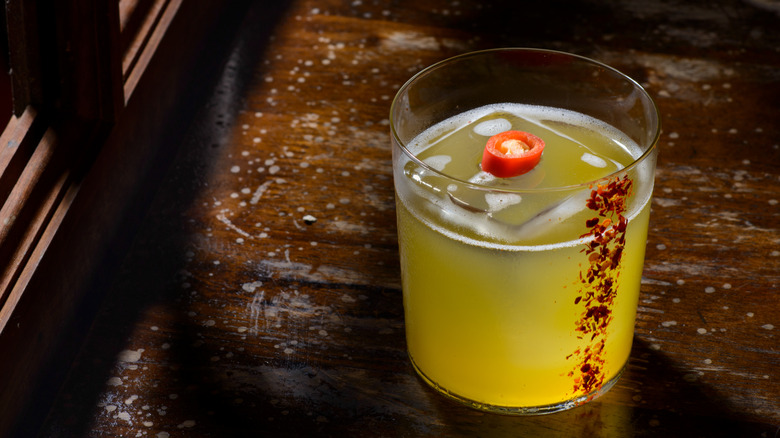Why Margaritas From A Bar Are Better Than Homemade
A margarita is one of those classic cocktails everyone should try once. It seems like the sort of drink that would be hard to get wrong, but there's actually a lot of care and attention that goes into making them. That's why margaritas from a bar are usually better than homemade. Good mixologists know what they're doing and craft them carefully so they're delicious every time.
But if you've ever made margaritas at home and were disappointed with the results, you might be wondering how, exactly, the professionals do it better. I used to work as a bartender, so I've made a few margaritas in my time. However, I also talked to a couple of bartenders and mixologists to get the lowdown on what they think makes a great margarita and how this differs from the way people tend to do it at home. Using this information, I'll be delving into what makes a margarita from a bar better, on average, than one you make yourself at home.
Ingredient quality is one of the primary concerns, with pros thinking carefully about what they use, whereas the average person making drinks at home uses whatever they can get their hands on. But, there's more than that. From shaking technique to how you salt the rim, it all plays a part in the quality of the finished drink. Read on to learn how bartenders do it better — it might just make you want to up your home margarita game.
Bartenders avoid premade mixers or bottled lime juice for margaritas
Be honest, when you make margaritas at home, do you prepare them fresh or do you use a premade mixer? Good bartenders never touch margarita mixes, so if that's what you've been using at home, no wonder your drinks aren't up to snuff.
"Don't touch the stuff," warns Levi Tyma, bartender and general manager at Central Park Bar in Chicago. Instead, he says you should always use fresh lime — the bottled stuff is out of the question. You shouldn't use pre-squeezed lime juice for margaritas because it just doesn't taste the same. Lime juice loses its complexity quickly, once squeezed. The bottled type also contains preservatives and is squeezed from poor quality limes to start with. We know it's convenient, but ditching the bottled variety in favor of fresh limes is the only way to go for excellent margs. And any good bartender knows that.
Aubrey Slater — head mixologist for Saint Luna — agrees that fresh lime is the way to go. And limes are important, too — they shouldn't be an afterthought. "It would not be a margarita without the lime," Slater remarks. She adds that "you can play around with the types of lime you use." While most people stick with Persian limes, you can also use Kalamansi or Key limes and see how that affects the flavor.
Margaritas from a bar are made with a careful choice of tequila
Margaritas are made with tequila. When you're throwing these cocktails together at home, you might just use whatever you have in your liquor cabinet or the type that was on offer when you went to the store. But, bartenders think carefully about their tequila choice. Not every professional has the same opinion about the type of tequila to use, but you can be sure they will have picked deliberately, thinking about what it will bring to the drink.
Aubrey Slater likes to use reposado in her margs. This literally translates to "rested" and is an aged version of the spirit with a golden hue. "It gives the tequila a smoother, more well rounded flavor," says Slater. It also "adds a bit more complexity to the cocktail, introducing light flavors of vanilla and wood," she notes.
But Levi Tyma says the tequila he uses in his drinks depends on who he's making them for. "I prefer a nice blanco — which is grassy and bright — that's not going to break the bank," he says. Blanco is clear, unaged tequila. It isn't as smooth and sweet as the aged stuff, but some people prefer this. He recommends Espalon Blanco or Lalo Blanco. However, "if it's someone that wants a sweeter margarita, Casamigos Reposado always does the trick," Tyma says. If you're unsure what you prefer, it's a case of trial and error.
Mixologists think about which orange liqueur to use in margaritas
Everyone knows about the tequila and lime that goes into a margarita, but if you're making this cocktail at home, you might forget about this orange liqueur. It's an important part of the drink, though. A good bartender will never overlook it, of course. But more than that, they will have thought carefully about which one to use.
Aubrey Slater talks about the importance of the orange liqueur. It's a vital component of the drink and one that you don't need to get experimental with. "A nice quality triple sec is what you want to go with," Slater tells us. "I prefer to stick with the classic, Cointreau." However, you can branch out and go for fancier options, if you like.
Levi Tyma prefers Pierre Ferrand Dry Curaçao. "It's a bit pricey, but it's worth every penny," he says. But he doesn't think it plays as vital a role as Slater does. "I would say it's important, but not necessarily a main character," he says. Tyma usually uses a little less triple sec than a classic marg contains — around half to three quarters of an ounce rather than a whole one.
The sweet-salt balance is just right in a margarita from a bar
When you get a margarita from a bar, the balance of sweetness and saltiness will be just right. This can be tricky to perfect, though, and might be when your homemade versions are missing the mark. Levi Tyma adds a pinch of salt directly to his margaritas. This can make all the difference when you're finding the balance between those sweet and salty notes.
Salt isn't just a garnish, it makes drinks taste better overall. There are benefits to adding salt to cocktails. In a margarita, it softens the edge of the lime's acidity and brightens the sweetness of the triple sec. This leaves you with a much more well-balanced drink. It's not just a mix of sweet and sour notes, there's more to it than that.
Bartenders work hard to perfect this sweet-salt balance over time. They start by adding just a little salt — often in the form of a saline solution for more even distribution — then taste the drink, noticing if the sweetness feels shy or if the acidity bites too hard. They make adjustments, tweaking things until they're just perfect. Ultimately, they end up with a great recipe, which is what Tyma says goes a long way when making a quality marg.
Professionals consider their shaking technique
You might think that shaking a cocktail is simple. But there's actually a lot that goes into the technique that a layperson might not realise. Professional bartenders have perfected their shaking technique and consider the best way to approach it for the perfect drink.
If you want to get better at shaking at home, you'll need to practice. "Try to think about rotating the ice inside the shaker in a figure eight fashion, versus just trying to blast it from one end of the shaker to the other like a particle accelerator," advises Levi Tyma. You're not just shaking as vigorously as possible, there's some nuance to it.
Aubrey Slater tells us that large ice cubes are best for a shaken citrus drink. And she has her own approach to finishing it. "Now I may get some guff for this, but I prefer a dirty dump with my marg," she says "That's when you shake your cocktail and instead of straining, you just dump the cocktail into the glass." Tyma calls this technique a "roll" and says it's an alternative to straining that some bartenders use for margaritas. The main difference is that, without straining, you get a more rustic drink with some lime pulp and shards of ice that may have broken off the cubes.
You may get a half-salted rim at a bar
One subtle way some bar‑made margaritas stand apart from a homemade one is a half‑salted rim. Instead of coating the entire glass, you sometimes find that bartenders salt only half the edge. This gives drinkers control over how much they get with each sip.
Salted rims help balance a margarita. They can temper both the sweetness and the sourness of the drink, so it doesn't lean too far either way. But too much salt can be overpowering and nobody wants a straight-up salty cocktail.
"Personally I prefer my margarita without salt, but there's a lot of folks out there that love the salt," says Aubrey Slater. So, when she's making drinks for a customer, she chooses to salt half the rim to give them the option of how much salt to get with each sip, or allows them to skip the salt altogether, if they choose. I
Levi Tyma highlights how crucial restraint can be: "The salt rim definitely will impact the final product," noting that it can make the cocktail too salty if you've already added some salt to the drink itself. "This is why, if you do want a salt rim, only salt rimming half the rim is key," he remarks. By limiting the salted portion, bartenders avoid excessive brininess while still making a well-balanced beverage.
Bartenders keep classic margaritas simple
You might think that more complex is always better, but good bartenders don't agree. If you're trying to make a classic margarita, you should keep it simple. You don't want to gild a lily here. This iconic cocktail is already perfect in its simplicity, you don't have to mess with it.
"If it ain't broke, don't fix it," are the words Aubrey Slater lives by when making margaritas. "I believe the biggest mistake is adding too many ingredients," she says. She's a purist who sticks to a three-ingredient recipe: tequila, lime, and triple sec. She eschews any twists to the basic recipe, like adding a simple syrup or orange brandy.
But not everyone is so puritanical about it. Levi Tyma doesn't go wild with extra ingredients but is happy to add simple syrup or agave nectar to sweeten the drink a little, which is good news for anyone who finds basic margaritas a little on the sour side. He's also willing to substitute triple sec for orange curaçao. This orange liqueur is ultimately very similar to triple sec but is made with the peels of bitter oranges. It's a little more complex, so it can add an extra dimension to a margarita.
Essentially, all bartenders have their own definition of keeping things simple. Some stick to three ingredients only, while others have a little more leeway for experimentation. So, you might not be sure exactly what's in your favorite mixologist-made marg. Still, the ingredients are sure to be fairly understated.
The finishing touches are important
Yes, it's good to keep a classic margarita simple, but that doesn't mean you have to abandon any garnishes or twists. Finishing touches are important — you'll often find them on drinks from bars. You should have fun and be creative with them, as Levi Tyma suggests. This is a great way to make a bartender-quality marg at home.
Tyma says that the exact garnishes you should use depends on the type of margarita you're making. For instance, for a classic marg, "a lime wheel on the rim is classy, as is a dehydrated lime wheel on the surface" but "you can always get crazy and go with a skewer of Tajín dusted half strawberries," he tells us.
But, the finishing touches are likely to be different for other kinds of margaritas. For instance, you might have a slice of fresh mango adorning a mango version of the drink or a sprinkling of rose petals over a fruity marg. Some bartenders have special finishing touches when rimming the glass, too. Adding Tajín to the salt on the rim gives the drink a savory twist. Others might mix salt with sugar or even rim the glass with vanilla sugar, depending on the variation.
Bars may have seasonal margarita variations on the menu
A classic margarita should be simple and understated, but once you learn the rules, they're there to be broken. Bars often have variations on the menu. These might be seasonal margaritas or other fresh takes on the basic recipe. And they're probably different and more thought-out than something you'd come up with at home.
"The fun thing about mixology is taking a classic cocktail and riffing on it," says Aubrey Slate. She has a number of ways that she adds variations to margaritas. For instance, adding hot peppers to a simple syrup to mix in the drink; experimenting with different citruses like blood orange or pink grapefruit; or using moonshine in place of tequila.
Levi Tyma regularly makes margarita variations at Central Park Bar. Its signature drink is the Frozen Spicy Mango Margarita. "We sell thousands and thousands of these over the summer and in the winter too," says Tyma. They use a spicy tequila and mango purée to make it.
But he also likes seasonal variations. "If it's fall or winter, I will use a reposado or añejo tequila, whereas in the summer, it's all about that blanco," he notes. Blanco has a fresher flavor, whereas reposado and añejo tequilas are richer and warmer. He may use a cinnamon syrup in fall or winter, or a dash of Angostura bitters. While, in summer, maybe mango purée or prickly pear liqueur can create fun variations. Frozen margaritas are also a popular choice for the summer.
Bartenders stick to tried and tested ratios and recipes
When you buy a margarita at the bar, the likelihood is that the bartenders are using tried and tested recipes and ratios. They might use a classic margarita ratio or a recipe that's been tweaked and developed by the head mixologist where they work over time. They're not just using some recipe that they found on the internet or throwing ingredients together without measuring.
Aubrey Slater says that she sticks with a standard margarita ratio — "2 ounces of tequila, 1 ounce of triple sec, and 1 ounce of lime juice." This is a good, if basic, place to start from. You can tweak and riff on it from there. Or you can just stay true to the classic. Many people make the mistake of using too much tequila or not getting the right balance of sweet and sour ingredients when making margarita at home. So, it's good to have a guideline to work with, and it's easy to scale up when making drinks for a crowd.
Levi Tyma has a slightly more complex, but still pretty classic recipe. His is "two parts tequila, one part lime (or lemon) juice, half part triple sec or orange curaçao, and half part simple syrup or agave nectar." Replacing some of the orange liqueur with a simple syrup makes it only slightly sweeter and a little less alcoholic.
Margaritas from a bar look good, as well as tasting good
Part of why your fave margarita from a bar might seem so much better than the ones you've made at home is down to the way it looks. It probably looks good, as well as tasting amazing. Sure, appearance isn't everything, but there's a reason why fancy restaurants have beautifully plated food. It makes people perceive it as even tastier.
"You eat with your eyes first," says Aubrey Slater, which is why bars make their drinks look appealing. She says you should "take that extra time to make sure your salt is put on properly with clean lines" and "use a fresh cut lime wedge with the pith trimmed off." These little touches will make the drink look neater overall and more appealing.
We've already talked about garnishes, but these add to the overall look of the drink. The right selection of finishing touches, arranged artfully, can make a margarita feel all that more fancy. So, if you're trying to up your home mixology game, have a think about what you add to it — don't just dump it in a glass.
Speaking of, the glassware you use makes a difference to the look, too. A stemmed margarita glass is a classic, but a double rocks glass is good too, and feels a bit less fussy. Investing in some nice glasses, according to your preferences, is worthwhile if you regularly make drinks at home.
